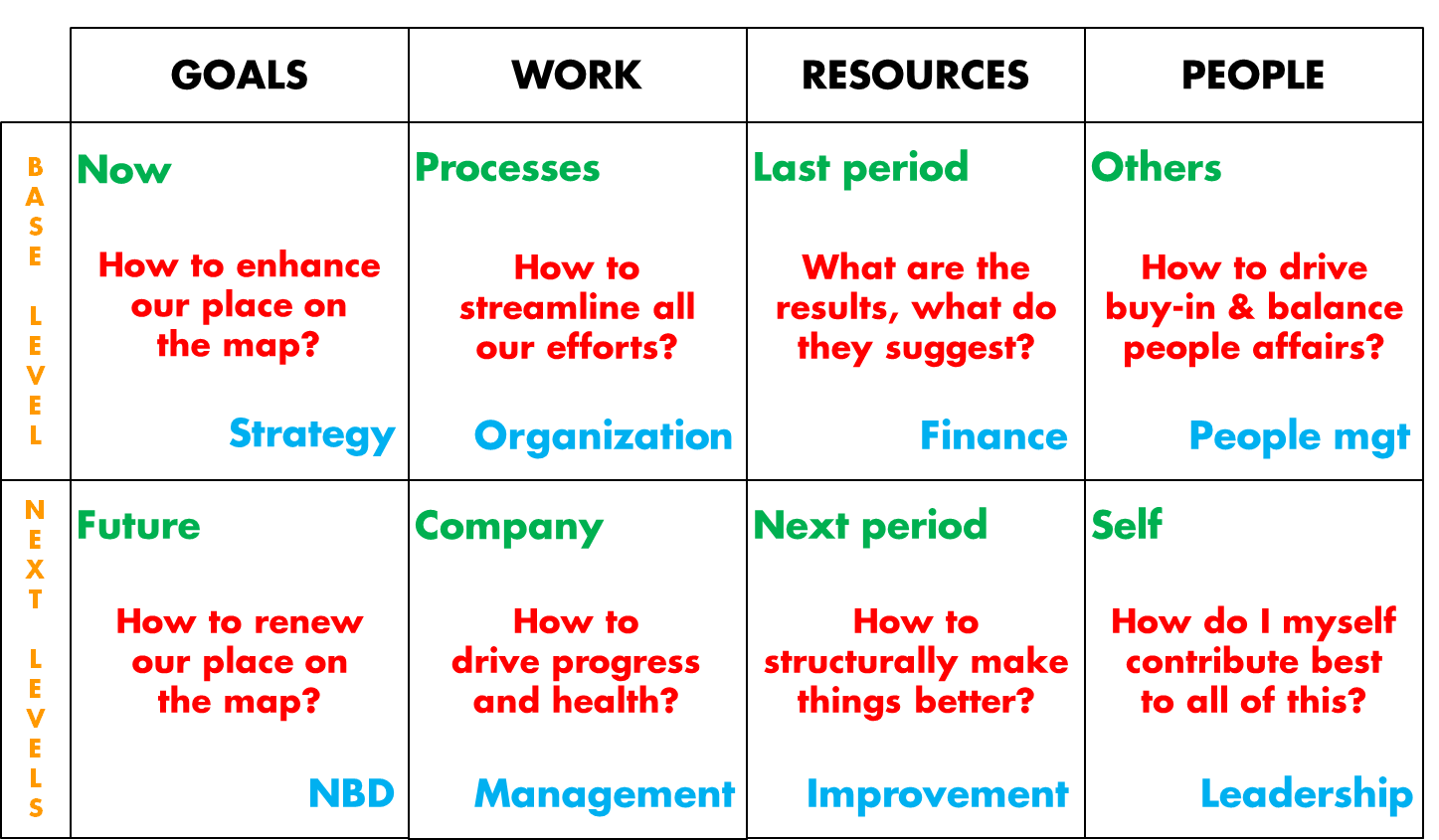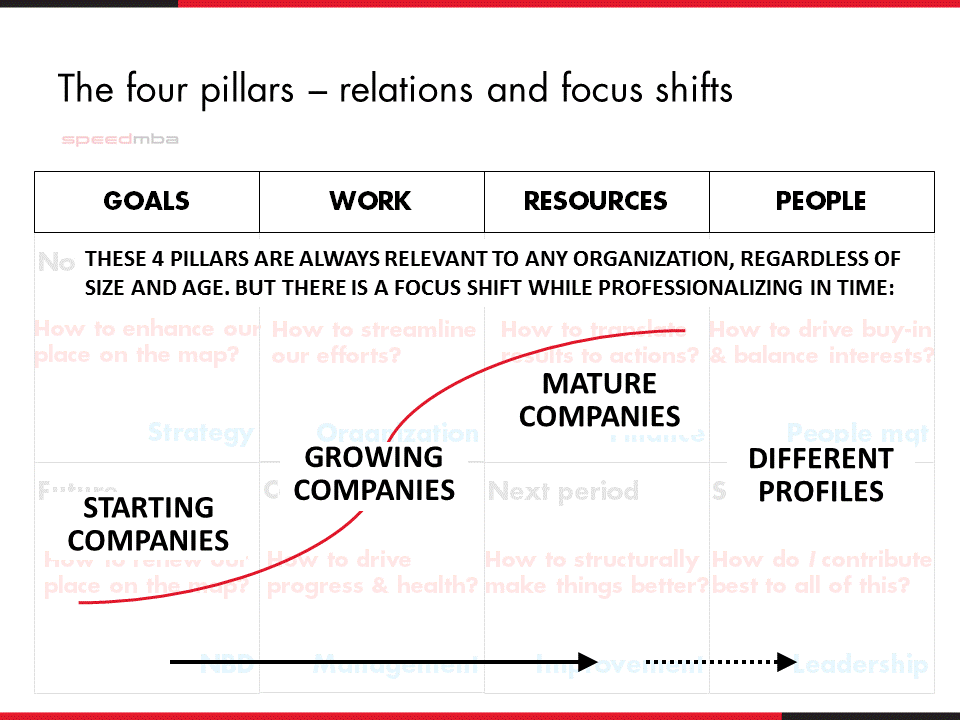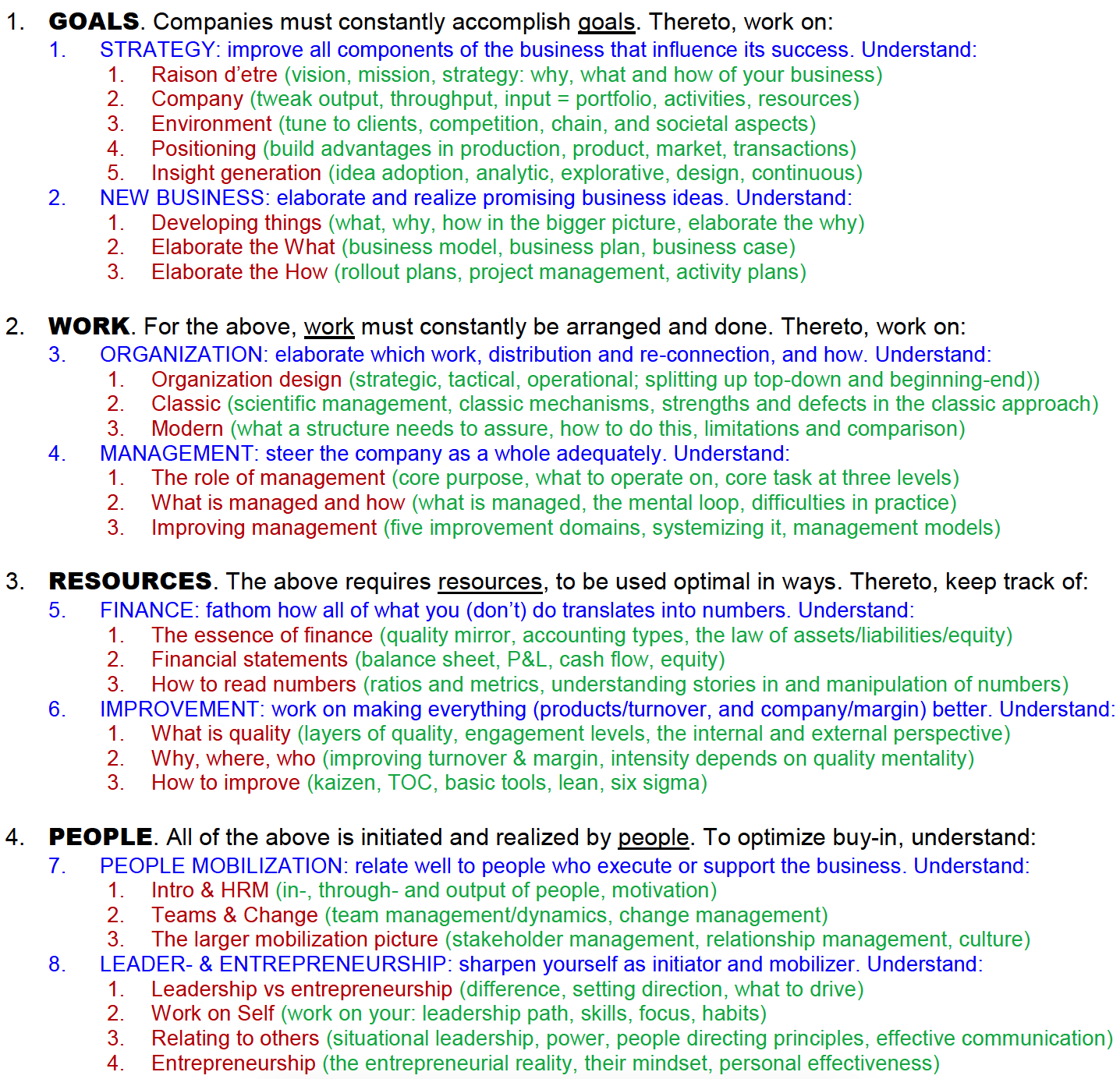This long-form article sets out what running any business is all about in terms of 8 key domains, and the connections between them. Thereby you’ll have insight in the core of all the business administration programs in the world. And in what you, as a manager, may get to deal with. That’s handy, because “all of business” is a lot and can feel chaotic. And because it’s worthwhile to understand the configuration and basics of the whole if you’re in business. This article gives away the main framework of my extensive course, which I’ll briefly come back to at the end.
The starting point is my framework that sums up all of business. Fun fact: my publisher suggested that this could become the global new standard for how to organize/integrate business insight.

The highest-level logic of any company is:
- Organizations continuously want to achieve goals (“the right things”).
- To achieve this, work has to be arranged and done (“the right way”).
- This requires resources that must be used in the best possible way (“the right results”).
- And all this is instigated, driven, and realized by people (“the right buy-in”).
This is a universal logic. There is no organization that does not aim for something, and does not involve work, resources and people. This applies to every organization, regardless of size, age, nature, location or sector. So to the freelancer and multinational, startup and centuries-old business, commercial and non-commercial, Dutch and Japanese, oil and coaching and entertainment industry.
You can also link four core variables to these pillars. In line with goals, work, resources and people, you want your company to be effective, efficient, profitable and pleasant. These are four areas to attend to separately, because you can “be” any of the four, without being the other three – for example, it is well possible to be profitable without being (really) effective, efficient and pleasant. And so on.
Let’s go one level deeper.
GOALS: the right things
- If you look at the now, you may want to enhance your place on the map. That’s the domain of Strategy.
- If you look at the future, you may want to develop entirely new business: New Business Development.
WORK: the right way
- In order to streamline all tasks and processes and make them run smoothly, you have to design or structure the organization.
- For the monitoring of organizational health and for directing the whole, you work on Management.
RESOURCES: the right results
- You want regular insight into the results of all the resources you have deployed in the past period, which you can find in Finance.
- You may want to make structural improvement efforts for the coming period, which is done through Improvement (also known as Excellence, or Quality).
PEOPLE: the right buy-in
- Regarding others, you need to get buy-in from all the groups that help realize your business; this is done through People Mobilization.
- Regarding yourself you can ask how you can sharpen yourself in order to better contribute to everything, and take it to a higher level; this can be done through more insight in Leadership and Entrepreneurship.
We’ll go a step deeper again.
A brief explanation of these eight domains:
Strategy
A company needs to keep itself successful in the world. Strategy is the well-considered approach to this. It boils down to tweaking elements of your company so that it performs better. This could mean working on what your organization delivers at all, what market advantages this has (in itself, but also in relation to competition), what you need to arrange for this, what you need to know about your customers, how you can effectively target them with marketing and sales, how you shape strategy, what vision and mission can possibly do for you (note: you don’t necessarily need them), and more.
New Business Development
A special form of strategic action, not necessarily from an existing business for that matter, is the development of entirely new business. This is not about tweaking the established business, as you first have to crystallize and build up everything from scratch. Core tasks are therefore the elaboration of what the business should be (which can be done by means of a business model canvas, a business plan and/or a business case), and the elaboration of how you are going to realize this (e.g. by means of a lean-start/scrum approach, or another development or project management method).
Organization
Once you are in business, you need to make sure that the execution of your operations runs smoothly. As more people are involved in this, a clear and fixed division of work becomes more important, i.e. the “design” of the organization. For a long time, this has been based on the principles of scientific management, leading to traditional structures characterized by hierarchy, tight process control, functional division of labor, and some other practices. Because such structures have proven to lead to considerable disadvantages, more modern forms of structuring that reduce those disadvantages have emerged.
Management
In addition to a good design for streamlined operations, which at first glance could appear as a one-off task, there must be continuous attention for and control of the health of the company as a whole. That’s what management is all about. This takes place at various levels, although you can also say that the company needs to be healthy in relation to the outside world, but also when you look inside. Management is about information and decisions. There are many (well-explainable) complications to this, so managers are often more concerned with ad hoc responding to issues than with building things. But there is a range of options to improve management.
Finance
All your efforts to consolidate your market position, to renew it, to be well organized, and to manage it well, should lead to good financial results. But you have to understand the basics of finance if you want to be able to do something with that information. It seems to be a confusing area: you can be productive but not profitable, or vice versa. You can be solvent but not liquid, or vice versa. It can be attractive to be in debt, or not. You can be profitable in the books, but be declared bankrupt in practice. At the end of the day, all concepts and insights interlock logically. And no matter what you see in the balance sheet, profit and loss, cash flow statement, or metrics: the most important thing is that through all the numbers you keep seeing the story of what has been the case. So in a fundamental sense, finance is not about numbers.
Improvement
Whether you like your results or not: things can always be improved. You then enter the field of improvement, also known as “quality” or “excellence”. How far you want to go with this depends on your industry, and on how you see the balance between the pros and cons of it, which is partly a matter of personal preference. It is a broad domain, because there are all kinds of approaches to pursue improvements. More intuitive or more systematic. More or less strict (in a certain approach, you have to see an arbitrary improvement as a deterioration). More general or more specific. The holy grails in this domain are Six Sigma and Lean (which is sometimes confused with scrum).
Mobilizing people
All of the above must be executed (by e.g. employees and suppliers) and supported (by e.g. customers and shareholders). Because of this dependency, you need attention for the right buy-in. All stakeholders in a company have a choice between you or many others. So they will only want to stay with you, if they get enough of what they are in it for. And otherwise you’ll get complaints, absenteeism, obstruction, demands, pressure, bad exposure, or they just walk away. Since you don’t want that to become your work focus, you need to have your HRM, team, change, stakeholder, relationship and possibly culture management in order.
Leadership and Entrepreneurship
In the last and in the first place, all the above is initiated and driven by someone. The development and success of the company can strongly depend on this person. So on you; MBA insights assume that you are in the drivers’ seat. This is all about leadership and entrepreneurship. The first is about how to become more “follow-worthy” to others, the second is about how to achieve more by yourself. In both areas, it can be very rewarding to work on yourself. You’ll develop yourself on your focus, skills, habits, style, effective communication, personal effectiveness, and more.
Some additional logic of the overall model
You see that the eight domains have arisen from logical distinctions that together form a unity (like: others versus yourself, past period versus coming period). The eight domains are arranged in two rows of four. The first set of four is the “basic layer”: if you have sufficient success in the market, and your processes, financial results, and the buy-in of your stakeholders are all okay, you’re basically all good. If you want more, you can sharpen things within those domains, or go to “next level” domains, where, following the four pillars, you can develop new business, enhance management, start improvement initiatives, and sharpen yourself.
Back to the four pillars (goals, work, resources, people) where the eight domains came from. Although these four are always relevant to any company, you can see that the focus on the pillars shifts with the maturity stages that you are in as a company. See this picture of the natural growth curve, after which an explanation follows.

If you’re not well-established within the environment yet, or if you’re not even in business yet, the focus is on the Goals-pillar (and everything it entails). After all, you really need to have sufficient success in the market before things like efficiency and systematization become interesting.
Once you start growing, you have success with what you do. That’s why you can scale up, and quickly more and more people come to work in the company. Then it will become clear that the old ways of working and managing no longer suffice. Your organization design and management have to change, so this Work-pillar is where the natural focus now will be on. No longer on the goals, because it’s a given that you score well here. And the focus is not yet on resource optimization either. In growing companies there is room for everything.
Once you have fully grown with what you do well, while your organization and management have grown with you, you are at a mature and stable level. This is when the focus moves to “achieving more with the same” (or even more with less). So a focus on pillar three, on optimizing resources. This is why you see that corporates are strongly driven by financials and improvement programs. The focus on the first two pillars is gone, because they are “given” and crystallized.
Where does this leave the fourth pillar of People? On the one hand, you can say that the focus moves here in a new development phase “beyond” maturity, where “enlightened” managers want to go beyond the financial bottom line, with a focus on higher quality relationships with all stakeholders. While they are also interested in developing themselves.
On the other hand, you can say that People pillar facilitates a specific look at the first three pillars and growth phases, because you need different types of people for the different phases (note that people categorization models fall into that fourth pillar). Companies at the beginning of the curve need initiators, self-starters, visionaries, people who like to take the lead. Companies that are growing fast at the middle of the curve need managers, organizers, regulators, fixers, coordinators. And companies at the top of the curve need experts, finishers, system-enforcers, good practitioners. So everyone has their place. And by consequence you can also see, for example, that the founders of a company, when they get to the growth phase, are not necessarily the most suitable people to manage this growth.
This is the whole story!
Everything you come across regarding business (in your work, in newspapers, in books) can be placed in the given framework of the four pillars and eight core areas. Of course, it requires more detailed insight into all the more concrete matters that these domains entail, but with the logic outlined, you’ve got the bigger picture.
How is this useful?
To start with, the framework offers a clear overview of everything that may play a role, including a logic of how the domains relate. That gives you mental grip on the whole. In addition, it gives you the opportunity to better understand the basics of each domain, and what they all entail. This allows you to systematically fill your mental toolbox by which you can examine all kinds of business issues. This in turn will empower you to see more quickly which domains certain issues to deal with pertain to, and which tools are available there, in that big world of business insights.
Example. If you’re dealing with political games, you might think: that’s between people, so I have to be in the fourth pillar. Wrong. Organizational politics is related to conflicting interests, and these stem from how the organization is structured, or from how things are managed. So you have to find the solution in organization design or in management. And when the issue indeed is about conflicting personalities, e.g. in a department or in an MT, then you indeed can to go to pillar four, to draw on insights about team management, or people characterization models (helping you to explain differences, which makes friction more understandable, and thereby offers a reaching hand for relaxation).
To go one last (but very compact) step deeper, here is an overview of the even more concrete topics that fall under the core domains. The four colors can be seen as four levels of unfolding detail.

If you find this an interesting framework, and you want insight into all the topics from this last overview, go for SpeedMBA Online. A short explanation of what this is.
SpeedMBA Online is an online business training for ultra-compact, timeless, complete business understanding. It is an ultimate source of insight that you can guaranteed consult more often in all kinds of challenges that you will face, if you have to do “something” with business (e.g. wanting to develop a strategy, or to improve sales or marketing or management or teams or margin or yourself, etc).
The package consists of an online course (videos and/or audio and slides), a “self-consultancy” book that provides you with helpful ideas over and over again for all kinds of challenges, and 52 weekly summaries of the best books in the world on business and productivity. This way you will get a yet better understanding of how EVERY business works, plus all the top books on it. An ultimate source for quick understanding in days, and years of use. And it couldn’t be much more affordable for what you’re getting.
Ideal for if you [1] as a manager/entrepreneur regularly have challenges, and would see the value of a structured source with useful insights to enhance your thinking process, [2] as a specialist (medic, engineering, psychology, etc) have rolled into a management position (if only because you are starting your own business), and want to get up to speed quickly, [3] as a senior manager are interested in a refresher, in an integrative framework in which all your experiences get logically linked, [4] are simply eager regarding business knowledge and development of yourself.
SpeedMBA … Complete business knowledge. Clear. Structured. Applicable. Fast. Zero fluff. With money back guarantee.
Understand the blueprint of any business
Improve your business in many ways
Become a match for any management
Feel the satisfaction of understanding it all
All this and more, when it suits you, online
Dr. Machiel Emmering from & about SpeedMBA:
This course brings you everything you need to understand and improve any business. Developing new business, improving strategy, organization, management, finance, improvement, mobilizing people, plus leadership and entrepreneurship: everything gets peeled off step by step, to the level of practical applicability.
Every performance-oriented entrepreneur or manager understands that such broad insight is useful. But this is usually sold at a high price, and positioned as meant only for the business elite. Nonsense. Sound business insight is for anyone. Fun “secret”: most managers and MBA alumni don’t even have all this knowledge readily available.

